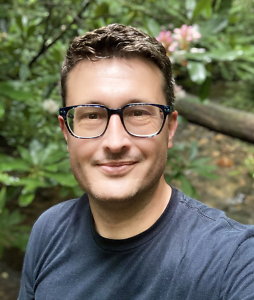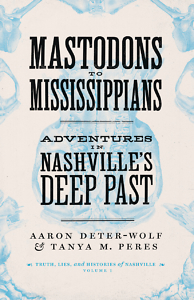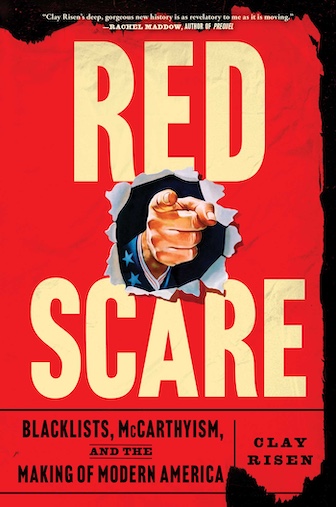The Story Beneath the Sprawl
Mastodons to Mississippians explores ancient Nashville
FROM THE CHAPTER 16 ARCHIVE: This interview originally appeared on August 19, 2021.
***
The remote past of the place we now call Nashville has been the source of a fair share of fanciful lore, from a hoax about an antediluvian human giant (in reality, a mastodon skeleton) to Nashville Predators mascot Gnash, inspired by saber-tooth cat remains found beneath the city’s downtown. Archaeologists Aaron Deter-Wolf and Tanya M. Peres serve up a few such stories in Mastodons to Mississipians: Adventures in Nashville’s Deep Past, but the book is really a brief, fascinating survey of the rich archaeological record of the region and a primer on the human communities that thrived in it thousands of years before Timothy Demonbreun arrived. It’s also plea for preservation of sites under threat from the city’s raging development boom, as well as a sobering acknowledgment of what has already been lost.
 Aaron Deter-Wolf is a prehistoric archaeologist for the Tennessee Division of Archaeology, and Tanya M. Peres is an associate professor in the Department of Anthropology at Florida State University. They answered questions from Chapter 16 via email.
Aaron Deter-Wolf is a prehistoric archaeologist for the Tennessee Division of Archaeology, and Tanya M. Peres is an associate professor in the Department of Anthropology at Florida State University. They answered questions from Chapter 16 via email.
Chapter 16: You write quite a bit about fables, myths, and misconceptions around Nashville’s deep past, from the mastodon skeleton that was passed off as the remains of a giant human to erroneous assumptions about the diet of Archaic people in the region. Do you see an archaeologist’s job as fundamentally at odds with the storytelling impulse, or does an archaeologist try to tell the most well-grounded story possible?
Aaron Deter-Wolf and Tanya M. Peres: Most archaeologists would probably like to tell well-rounded stories that engage the public but unfortunately aren’t trained in that style of communication. Instead, graduate school teaches anthropologists to look for the nuances in our data and to be conservative in our interpretations so as not to misrepresent past peoples and cultures. The minutia of archaeological analysis includes things like sorting hundreds of thousands of tiny stone flakes. That’s essential to understanding past human activity, but neither the process nor the resulting data tables stoke the imagination of many non-archaeologists! Unfortunately, peer-reviewed science is much less approachable than sensational claims, and pseudo-archaeology isn’t just a relic of the 19th century. Several times a month Aaron gets emails from Tennessee citizens asking about everything from sasquatches and giants to ancient aliens. That’s why we wanted to write this book, to share some of the well-researched stories about Nashville’s deep past that aren’t generally known outside of the circle of archaeological professionals.
Chapter 16: Your account of the Mississippian culture in Middle Tennessee is fascinating and presents a much more complex picture of those communities than most of us received in Tennessee history class. What are the key questions about Mississippian life in this region that remain unanswered?
 Deter-Wolf and Peres: Archaeological excavations and examinations of older collections keep revealing new information about the Middle Cumberland Mississippian culture, which dates to about AD 1000-1475. Over the past decade we’ve learned some amazing things about their origins, beliefs, technologies, architecture, and how they interacted with the environment.
Deter-Wolf and Peres: Archaeological excavations and examinations of older collections keep revealing new information about the Middle Cumberland Mississippian culture, which dates to about AD 1000-1475. Over the past decade we’ve learned some amazing things about their origins, beliefs, technologies, architecture, and how they interacted with the environment.
Unfortunately, Nashville’s development and growth over the past 60-plus years has destroyed huge portions of the archaeological record. At this point we don’t even know what all has been lost, and we’re in a race to protect and learn from what’s left. A great example of this situation is the East Nashville Mounds site: a large Mississippian town on the east bank of the Cumberland River around what is today Top Golf and the planned Oracle development.
In the 1990s, excavations at the Jefferson Street Bridge found Mississippian homes and burials were still preserved beneath the modern industrial sprawl. Because of what’s already been destroyed, and the limited chances archaeologists will have to examine this area in the future, we may never know how many people lived in and around that town, how it was laid out, or exactly when it was founded. More importantly, we’re unlikely to ever understand the essential parts of their daily lives: how they organized their communities and homes, raised their children, the meals they cooked, and how they tried to persevere through decades of droughts and crop failures during the 13th through 15th centuries.
Chapter 16: The book describes the loss of many sites and artifacts through encroaching development, natural disasters, poor curation, and looting. The incident in 2009, when Aaron returned to an exposed burial site to find that it had been plundered, seems especially poignant. What can be done on the federal, state, and local level to better protect our archaeological heritage?
Deter-Wolf and Peres: There is a patchwork of federal and state laws that protect archaeological resources in the United States. Those vary depending on site location and if there are human remains present. Sites on federal and state lands are protected from disturbance and looting, at least on paper. On the other hand, under Tennessee state law artifacts on private property belong to the landowner. That means it’s legal — though not ethical — to collect or even dig into sites with landowner permission. Unless there’s federal or state permitting involved in a project, or burials are present, developers don’t have any legal obligation to avoid or protect archaeological sites.
Burials, burial monuments, and any associated artifacts are protected under state law regardless of land ownership, how old they are, or if they’re in a known cemetery. Those protections aren’t absolute, however. In the book we talk about how from 2016-2017 over 200 Mississippian period graves were removed from a property in West Nashville to allow for construction of a dental office and plastic surgery center. That work was done according to state cemetery laws, which offered no protections to the village site that surrounded the cemetery. Today most of that site has been destroyed by development, with almost no archaeological documentation.
To preserve what’s left, there needs to be a concerted public effort to acknowledge and protect our shared archaeological heritage. A great example of this is TVA’s “A Thousand Eyes” program, which relies on public assistance to protect archaeological sites on their properties. Those sites are protected by federal laws, but it’s almost impossible for archaeologists and law enforcement to actively monitor them on a daily basis. Improving legal protections for archaeological sites and cultural heritage and actively engaging with indigenous and descendent communities would also be important steps to take at both the local and state level.
Chapter 16: You make a distinction in the book between looters and collectors. Can you explain the distinction? Is there an ethical way to approach the acquisition of artifacts?
 Deter-Wolf and Peres: In the book we define looters as those who illicitly dig into archaeological sites in search of aesthetically pleasing artifacts. Those objects make up only a very small portion of the archaeological record and are often found in graves. There’s no way to sugarcoat it: Looters are graverobbers. In addition to plundering ancient Native American burials, they’re also destroying archaeological sites. All of the data, all of the “everyday” artifacts like charcoal fragments, animal bone, and tiny stone flakes that make up those sites, and everything we could learn about the past from those materials, is lost forever without careful archaeological documentation. Middle Tennessee has a strong tradition of avocational archaeologists — people who are not trained professional archaeologists but who care deeply for the past and have worked to carefully record, protect, and salvage endangered archaeological sites. The information those folks have shared with professional archaeologists is absolutely critical to understanding Nashville’s past.
Deter-Wolf and Peres: In the book we define looters as those who illicitly dig into archaeological sites in search of aesthetically pleasing artifacts. Those objects make up only a very small portion of the archaeological record and are often found in graves. There’s no way to sugarcoat it: Looters are graverobbers. In addition to plundering ancient Native American burials, they’re also destroying archaeological sites. All of the data, all of the “everyday” artifacts like charcoal fragments, animal bone, and tiny stone flakes that make up those sites, and everything we could learn about the past from those materials, is lost forever without careful archaeological documentation. Middle Tennessee has a strong tradition of avocational archaeologists — people who are not trained professional archaeologists but who care deeply for the past and have worked to carefully record, protect, and salvage endangered archaeological sites. The information those folks have shared with professional archaeologists is absolutely critical to understanding Nashville’s past.
Chapter 16: You note the importance of avocational archaeologists several times in the book, and you mention George Woods, a Black Tennessean who devoted much of his life to archaeological work, although he never received professional recognition. This work seems to inspire a real passion in people. Can you talk about what drew you to it and keeps you engaged?
Peres: In seventh grade my science and social studies class did a unit on Archaeology. It was just after the second Indiana Jones movie was out in theaters, and the teacher arranged a field trip to the Jacksonville Museum of Art to see the Ramses II exhibition. We also had a guest visit from an archaeologist from the Florida Museum of Natural History and did a mock dig in a backdirt pile behind the school. I was hooked, but when I started college I declared education as my major. My family, like many who do not personally know archaeologists, was afraid I would not find a job after I graduated. Two weeks into my first semester I changed my major to anthropology and haven’t looked back since.
Since my first field school in 1994, I have worked on projects all over the Southeastern United States, Mexico, Panama, and Scotland. What keeps me engaged is knowing that history happened everywhere, not just in faraway places. Unearthing the history that happened in our backyards is one small way we can learn and share about how people that were born, raised, fed their families, and spent their lives here.
Deter-Wolf: I’d planned to major in English in college but discovered a passion for archaeology while taking a class on Maya art and architecture. There was no archaeology major at my school, but over the summers I found my way onto excavations at ancient Maya sites in Belize and Guatemala and went on to graduate school for Mesoamerican archaeology.
Afterwards I went where the jobs were, doing professional archaeology for environmental firms out of New Orleans and then Nashville. I started with the Tennessee Division of Archaeology in 2007 and since then have worked at preserving and managing the state’s archaeological record while also getting to do interesting research with colleagues like Tanya. Over the years we’ve collaborated on projects from a mastodon site in Franklin, to Cumberland River shell sites impacted by the 2010 Nashville flood, and even a book on foodways archaeology in the American Southeast.
I also have a strong research interest in the archaeological record of tattooing, both here in Tennessee and around the world. What keeps me engaged is knowing that the artifacts we work with and the sites we study were made and used by real people. Through careful research we can connect with that past and learn meaningful things about groups and histories which have been overlooked and under-represented in historical narratives.
Chapter 16: The release of Mastodons to Mississippians is well timed, since September is Tennessee Archaeology Awareness Month. What sites and resources would you recommend to people who want to learn more?
Deter-Wolf and Peres: Tennessee Archaeology Awareness Month is a great place to start! That used to only be a week-long event and by the early 2000s had fallen by the wayside. In 2014, while Tanya was president of the Tennessee Council for Professional Archaeology, we worked with colleagues to relaunch the program and promote the legislation that turned it into a month-long celebration. Each year since 2014, the Council for Professional Archaeology has organized a “30 Days of Tennessee Archaeology” blogfest, which they host on their webpage. Those posts are short, easy reads and a good way to learn about some of the archaeology that’s been happening throughout the state.
Each winter the Tennessee Division of Archaeology and Middle Tennessee State University host the Current Research in Tennessee Archaeology Meeting, where archaeologists give papers on their recent research. That’s coming up January 22, 2022, at Montgomery Bell State Park and is free to attend.
There are a number of excellent organizations in Middle Tennessee that share archaeological information with the public, including the Tennessee State Museum, Historic Travellers Rest, Rutherford County Archaeology Society, and Middle Cumberland Archaeological Society.
There are also opportunities through Tennessee State Parks and the Division of Archaeology to tour state archaeological areas, including Old Stone Fort, Mound Bottom, and Sellars Farm. State Parks often offer archaeology-related programming and will probably be doing Archaeology Awareness Month events in September. There’s a full list of upcoming events online. Finally, over in Knoxville the McClung Museum of Natural History & Culture has a permanent exhibit on archaeology and the Native peoples of Tennessee.
[Read an excerpt from Mastodons to Mississippians here.]

Maria Browning is a fifth-generation Tennessean who grew up in Erin and Nashville. Her work has appeared in Guernica, The Los Angeles Review of Books, and The New York Times. She’s the editor of Chapter 16.





